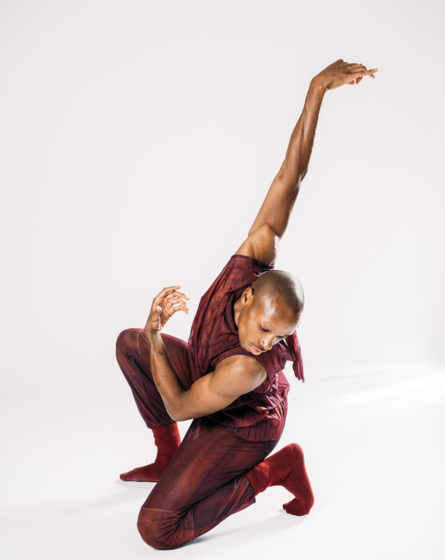In This Story

Biography:
Robert Rubama (They/He) is a graduate of George Mason University with a BFA in Dance. They have worked with The Metropolitan Opera, Haus of Bambi, Groundworks Dance Theater, Carolyn Dorfman Dance, Peridance Contemporary Dance Company, and Alejandro Cerrudo. Robert was an artist in residence at The National Building Museum, The Floor on Atlantic, and The Homeport Art House. Their recent work has been with Orange Grove Dance, Flockworks Dance, Yin Yue Dance Company, LaneCo Arts, and the Mark Morris Dance Group.
Robert is an independent choreographer, and their work has been performed by Company E Dance, Spark Movement Collective, Bucknell University, Cleveland Dance Project, Jane Franklin Dance, Luna Dance Company, and Terre Dance Collective. Robert is an animal lover, a daydreamer, and loves the color black.
My Interview with Robert Rubama:
What was it like to return to school as a guest artist?
Robert reflected on their time during residency, stating, “It was an honor to return to the School of Dance as a stager for Yue Yin's "Through the Fracture of Light." Working with the talented and dedicated students was a tremendous experience, and it was wonderful to reconnect with my former professors: Linda Miller, Christopher D'Amboise, and Karen Reedy. While assisting Grace Whitworth in restaging the piece, I focused on providing the dancers with tips to navigate a work as physically rigorous as Yin's. I emphasized the importance of connecting to their breath and managing their energy while performing. Additionally, I wanted to share safe ways to execute the movements that respected the choreographer's intent while honoring the individual needs of the dancers, as everyone is different.”
What experiences in Mason's School of Dance prepared you for making connections in the professional world? Were there any unexpected challenges you faced transitioning from a college dance program to a professional career? How did you meet those challenges?
Robert stated, “Some helpful experiences included choreographing for my peers and having the privilege of performing in the Gala during my time at Mason. These opportunities taught me how to lead rehearsals effectively and ethically, how to articulate my creative vision through both words and movement, and the necessary skills for working in a rehearsal environment. I also learned the importance of being a cover or understudy for a piece.
One significant challenge I faced was managing taxes as a freelance artist. I tackled this by conducting research and seeking advice from coworkers and friends who were in similar situations.”
Since your graduation, you have already become a successful dance artist, performing with various emerging and established contemporary dance companies while also being a creative artist in your own right. Can you share a little about these different aspects of your life as a professional artist? How do you maintain a balance between your own creative work and the demands of working with other professional dance companies?
They noted that, “As a professional artist, my work encompasses performing, choreographing, arts administration, and teaching, all while balancing a non-dance job. I maintain balance by being clear about scheduling with those I work with, establishing boundaries about my workload, and making financially sound choices.”
What advice would you give to current dance majors aspiring to become professional dance artists?
“1. Be curious” said Robert, “During your time at Mason, you will encounter various perspectives on movement. If certain approaches resonate with you, engage with that professor or guest artist to explore those ideas further. If you have interests outside of dance, pursue those as well (in areas like marketing, arts administration, photography, or videography). These additional skills can intersect with your work in dance.” They then said,
“2. Practice writing and speaking about your art.”
